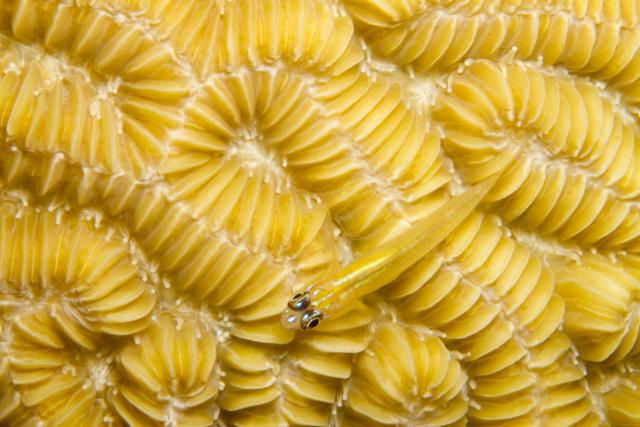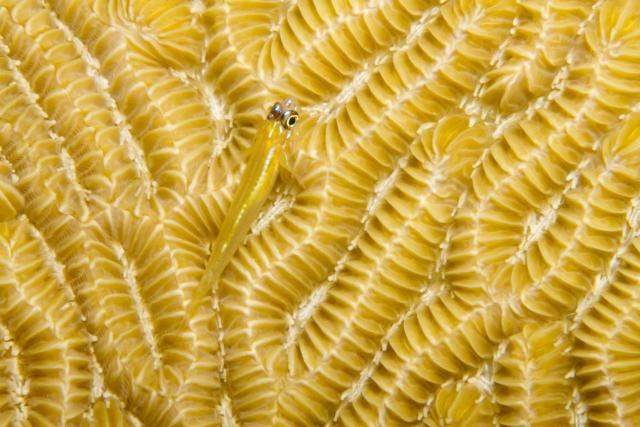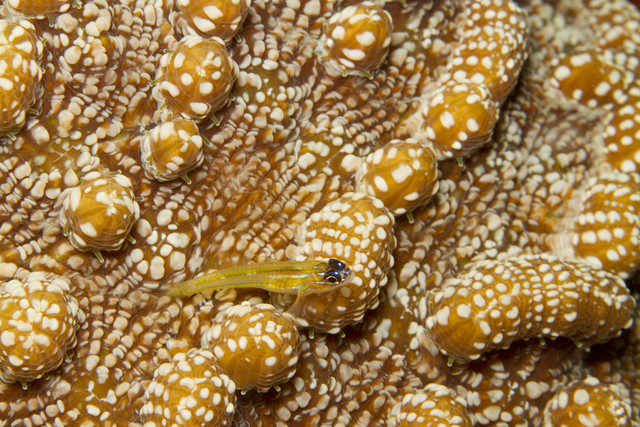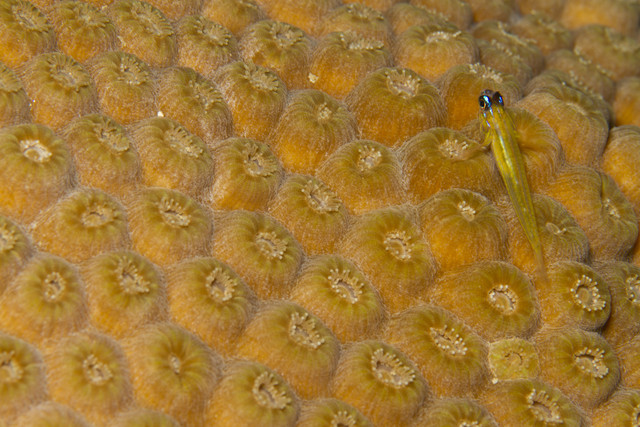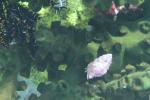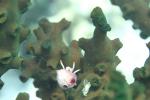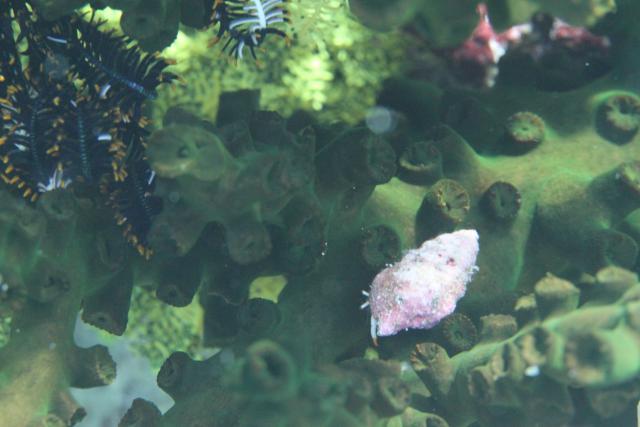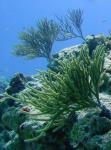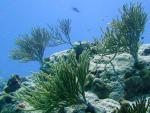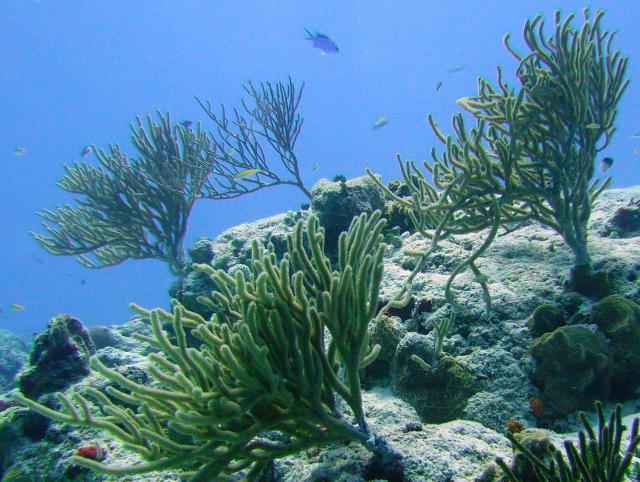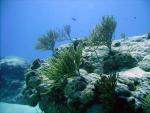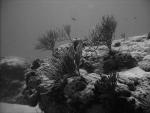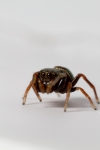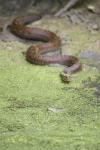coral
Turks and Caicos Explorer 2015: Patterns of the Reef (part 7)
ktuli — Wed, 12/09/2015 - 14:40
Ok - another entry in my Patterns of the Reef semi-abstract series. This one brings yet another Peppermint Goby (Coryphopterus lipernes), but this time sitting on some sort of brain coral (I couldn't get a species ID).
Because I couldn't pick which one I liked better, you get two shots this time...
Technical Data: Canon EOS 7D, Canon EF 100mm f/2.8L Macro IS USM, 1/200th sec at f/32. Image Stabilization on. ISO 400. Ikelite Housing and Port and Ikelite 161 Strobe in TTL Mode. Raw conversion in Photoshop CS5.
Technical Data: Canon EOS 7D, Canon EF 100mm f/2.8L Macro IS USM, 1/200th sec at f/32. Image Stabilization on. ISO 400. Ikelite Housing and Port and Ikelite 161 Strobe in TTL Mode. Raw conversion in Photoshop CS5.
- Bill
Aqua Cat: Patterns of the Reef (part 6)
ktuli — Wed, 11/05/2014 - 18:45
If you've been following along at home, you'll remember several other entries in this series. I don't know if it a combination of having the macro lens on and really looking at things in more detail, or the slightly reduced peripheral vision I get from wearing my scuba mask (I have a prescription mask, so my peripherals aren't as good), but I just seem to end up being fascinated with the patterns and the beauty in the abstract that I find on the reef...
Technical Data: Canon EOS 7D, Canon EF 100mm f/2.8L Macro IS USM, 1/100th sec at f/4. ISO 400. Ikelite Housing and Port with dual Ikelite 161 Strobes. Raw conversion in Adobe Camera Raw.
- Bill
Turks and Caicos Explorer: Fluorescing Corals (part 2)
ktuli — Thu, 11/01/2012 - 20:16
OK - this stuff is too cool, so here's another blast of fluorescing coral photos (today we're doing all vertically oriented photos).
One extra cool thing to note in this batch... the top photos on either side show a closed coral and the same coral with its feeding polyp tentacles opened. Pretty awesome, no?
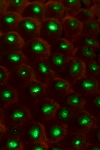 |
 |
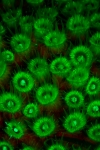 |
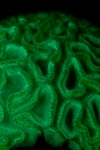 |
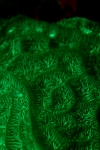 |
|
 |
 |
|
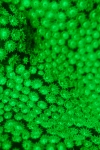 |
 |
Technical Data: Canon EOS 7D, Canon EF 100mm f/2.8L Macro IS USM with Yellow 12 Filter, 1/120th sec at f/8. Image Stabilization on. ISO 640. Ikelite Housing and Port with dual Ikelite 161 Strobes in TTL Mode both with NightSea BE3 Excitation Filters. Raw conversion in Photoshop CS5.
The second photo on both sides appear to be two different types of brain coral. One of the fun things we like to do during night dives is feed blood worms to the brain corals - I don't have any photos of that, but I do have a shot of an arrow crab catching a blood worm that I will share soon!
Stay tuned!
- Bill
Turks and Caicos Explorer: Fluorescing Corals (part 1)
ktuli — Wed, 10/31/2012 - 18:49
What up, fishes!?!
One of the things that I wanted to do on this dive trip was to check out the fluorescence on the reefs. You may have seen some of my land-based results with jumping spiders, but I still was blown away by the results I got.
The equipment I bought was made by NightSea and includes an excitation filter that goes on your light source (flash/strobe) and a yellow lens filter that acts to eliminate the color of the excited light. Basically, the excitation filters produce a bluish light that is the correct wavelength to induce the most common fluorescence responses - the yellow filter then removes that bluish light and returns things back to normal. We also had a special flashlight that had the blue excitation light, plus some yellow filters that went over the front of our masks so we could see the fluorescence effect that way too.
The results were stunning...
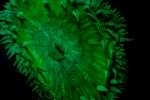 |
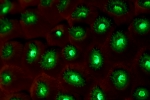 |
 |
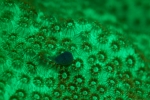 |
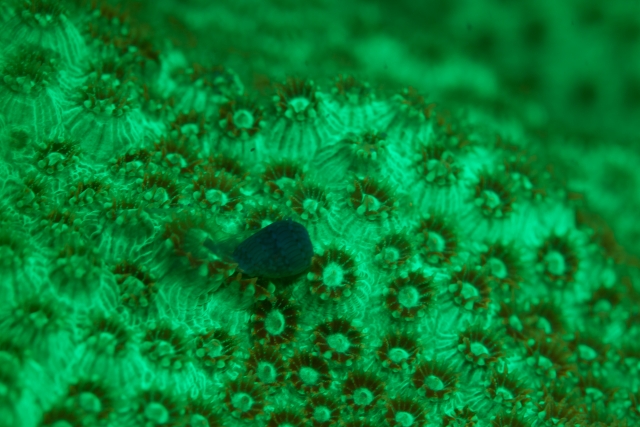 |
|||
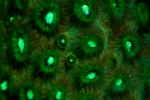 |
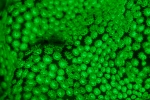 |
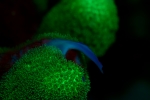 |
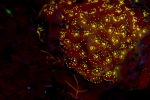 |
Not everything fluoresced on the reefs, so as we shined our lights along the corals, some would glow incredibly bright while others were just black and did nothing. I searched around for small critters like crabs and shrimp, but considering there were always hungry sharks or large horse-eyed jacks feeding during out night dives, it wasn't always the easiest thing to be looking for little stuff while not being able to see anything that wasn't fluorescing.
Maybe next time (and hopefully next time is soon!).
- Bill
Caribbean Explorer: Patterns of the Reef (part 4)
ktuli — Wed, 11/30/2011 - 16:40
Another in my Patterns of the Reef series. Like the second in the series, this one also features a Peppermint Goby (Coryphopterus lipernes), but this time it is sitting on what I believe is some Knobby Cactus Coral (Mycetophyllia aliciae).
Technical Data: Canon EOS 7D, Canon EF 100mm f/2.8L Macro IS USM, 1/120th sec at f/16. Image Stabilization on. ISO 100. Ikelite Housing and Port with Ikelite 161 Strobe in TTL Mode. Raw conversion in Photoshop CS5.
Like I've said, these patterns are just everywhere on the reef.
- Bill
Caribbean Explorer: Patterns of the Reef (part 2)
ktuli — Tue, 11/08/2011 - 17:25
Another installment of the Patterns of the Reef series today.
Technical Data: Canon EOS 7D, Canon EF 100mm f/2.8L Macro IS USM, 1/120th sec at f/16. Image Stabilization on. ISO 100. Ikelite Housing and Port with Ikelite 161 Strobe in TTL Mode. Raw conversion in Photoshop CS5.
This subject should obviously be a lot more identifiable with the small fish on the coral. The fish is a Peppermint Goby (Coryphopterus lipernes) sitting on some Great Star Coral (Montastraea cavernosa).
Probably not as strong as the first example, but still a fun exercise.
- Bill
Wakatobi: Hermit Crabs in Pink Shells
ktuli — Mon, 09/05/2011 - 13:31
I really can't wait till my upcoming dive trip, so I've been going back through some of my old shots trying to figure out what I could have done better. In particular, the one major problem with both of these images is the perspective. The top down view is not simply not very appealing. In this case, it was necessitated by the subjects' positions within the coral.
Oddly enough, these shots were taken on different dives, but they appear to be on the same species of coral. Further, the hermit crabs may even be the same species (notice the white legs with orange tips). However, the top down view makes identification almost impossible.
Technical Data: Canon EOS 7D, Canon EF 100mm f/2.8L Macro IS USM, 1/60th & 1/25th sec respectively at f/11.3. Image Stabilization on. ISO 3200 & 400 (Auto). Ikelite Housing and Port with Ikelite DS161 Strobe in TTL Mode. No post production.
I'm sure I'll still use this technique when absolutely necessary, but will also try to make sure I get different angles of subjects when possible.
- Bill
Wakatobi: The Elusive Damselfish
ktuli — Wed, 08/17/2011 - 21:23
I've looked for this fish in my identification book dozens of times. As it turns out, there appear to be local variants, and the one in the ID book just doesn't look much like this.
These little fish are called Indian or Cloudy Dascyllus (Dascyllus carneus). They are a small damselfish up to about 2.5 inches, but often as you can see a group of them range from every size. In Wakatobi, they were on pretty much every table coral like this, and would dart back into the coral as you approached. I managed to get this shot by slowly approaching the coral from below and coming up so I was eye level with the fish.
Technical Data: Canon EOS 7D, Canon EF 100mm f/2.8L Macro IS USM, 1/40th sec at f/8. Image Stabilization on. ISO 400 (Auto). Ikelite Housing and Port with Ikelite 161 Strobe in TTL Mode. Auto-smartfix in Adobe Photoshop Elements 8 (mouseover for original).
Have I mentioned that I really want to get back in the water sometime soon?
- Bill
Poll: Black Sea Rod Cropping
ktuli — Thu, 01/13/2011 - 17:50
Ok - that last post reminded me that I promised to share different cropping options for the 'winner' of that poll. So here we go... Three fairly different crop options with the color corrected version of the photo. As usual, mouseover the thumbnails for the larger image to display.
|
|
|
|
|
|
||
Hopefully by now, you know how this works... choose your preferred version below, then leave a comment with why you chose what you chose.
Thanks for stopping by!
- Bill
PS: I do have to admit that I removed the small Blue Chromis from the upper edge of the second version as it was actually cut off by my preferred crop line, and rather than move the crop line, I used the spot heal tool to remove the half fish leftover.
Poll: Black Sea Rod
ktuli — Mon, 12/13/2010 - 19:59
I have started receiving some of my Christmas presents to myself... I've been ordering some camera gear to make my upcoming trip to Indonesia much nicer. Stuff to try some night time-lapse, as well as to take my EOS 7D diving with me. But I'll get into all of that later.
All the research I've been doing to get the gear necessary to take my 7D diving has had me looking at different underwater photos, and a lot of places suggest black and white conversions. So I figured I'd give it a shot myself.
|
|
||
Technical Data: SeaLife DC600 at 5.4mm, unknown shutter speed at f/2.8. ISO 64. No flash.
All of the research for underwater camera equipment really has me chomping at the bit to get back into the water. Hopefully I'll be able to come back with some higher quality dive photos.
If my coral identification skills serve me right, this is Black Sea Coral (Plexaura homomalla) which is a branch yellowish gorgonian coral. It is fairly common around the reefs in Cozumel. The wide angle view of the original shot produced that typical blueish cast to the shot (remember, light travels much slower in water, and red color is the first to disappear).
With that in mind, I figured I'd try a quick bit of color correction on the photo as well as provide the black and white treatment. Place your vote, and leave a comment on why you chose what you did.
- Bill
PS: Working with this photo made me also consider some possibilities with cropping options, so perhaps once we have a "winner" of this poll, I'll run that version through some crop options to see what we can get out of that.
PPS: Also, stay tuned as I'll try to get myself back into a routine of posting by discussing the various equipment I bought myself for Christmas... ;)

